Dive beneath the thick expanse of ice covering the continent of Antarctica, and you'll be amazed at the abundance and variety of colourful marine life that lives in this cold, forbidding environment.
Issue information
Sea snails, starfish, crabs, sponges and many more eke out a meagre existence many hundreds of metres below sea level - far from the inquisitive eyes of the world's scientists and researchers, eager to learn more about them.
The Marine Life stamp issue was the latest in New Zealand Post's Ross Dependency series, celebrating our nation's long involvement with this wedge-shaped part of Antarctica. More than 3,000 kilometres south of New Zealand, the Ross Dependency was claimed as New Zealand territory by a British Order-in-Council in 1923. Today, it is also protected by by the Antarctic Treaty, signed by New Zealand and 11 other nations in 1959.
Supporting Research in Antarctica
New Zealand Post recognises that Antarctica's future lies in the hands of the scientists and researchers dedicated to finding our more about this fascinating part of the world.
With this in mind, New Zealand Post have sponsored postgraduate scientific research in the continent with an annual Science Scholarship. Research so far has covered topics as diverse as glaciers, beach development and sea ice formation to penguin antibodies and the thermal properties of Antarctic enymes.
Marine Life First Day Cover
A diver ventures into the depths of Antarctica's waters on our Ross Dependency first day cover - a hardy soul indeed, for this watery environment's temperature averages an icy -1.8 degrees Celsius.
An Intriguing Glimpse
The 2003 Ross Dependency - Marine Life presentation pack was a perfect package of information. It contained a set of the five stamps and the first day cover as well as further information on this isolated yet fertile marine environment.
Ross Dependency Postage in New Zealand
| Ross Dependency stamps are not valid for postage in New Zealand. Click here to find out more. | |
Product Listing for 2003 Ross Dependency - Marine Life
| Image | Title | Description | Price |
|---|---|---|---|
 |
Single Stamp |
Single 40c 'Red Seastar (Odontaster validus)' gummed stamp. The most abundant of the seastar species, the red seastar lives in the shallow shelf waters of Antarctica and grows up to seven centimetres from centre to arm tips. It's easily identified for the way it rests with its arm tips slightly raised - warning indeed to its prey, which include sea urchins, McMurdo sponges and other seastars. |
$0.40 |
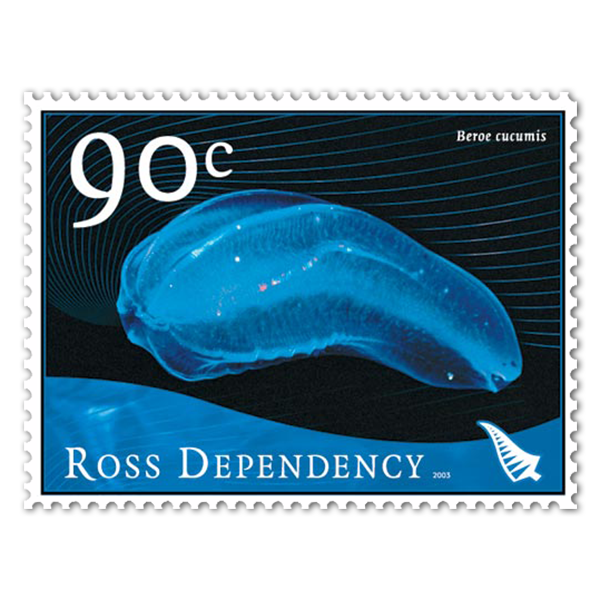 |
Single Stamp |
Single 90c 'Sea Gooseberry or Comb Jelly (Beroe cucumis)' gummed stamp. The comb jelly (also called a ctenophore) is sometimes mistaken for a jellyfish as it floats freely through the ocean. Made up of more than 95 percent water, these oval-shaped creatures have no bones or shells to weigh them down - they simply beat the tiny comb-like plates along their bodies to propel themselves along, and use their tentacles to capture food. |
$0.90 |
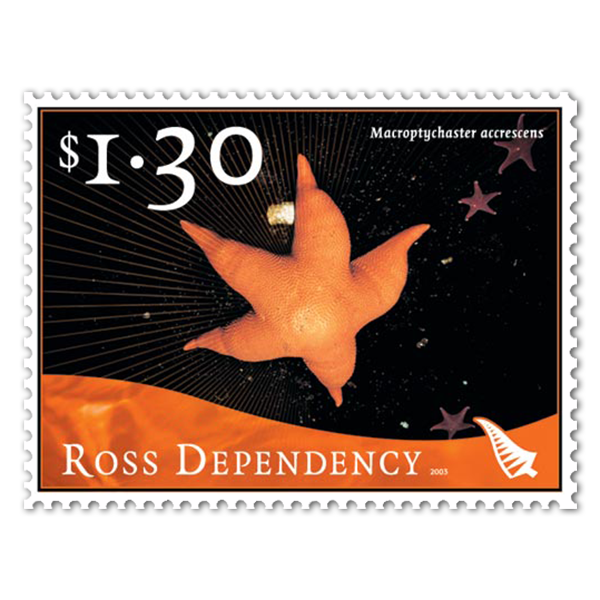 |
Single Stamp |
Single $1.30 'Giant Seastar (Macroptychaster accrescens)' gummed stamp. The giant seastar lives deep beneath Antarctica's ice and grows up to 26 centimetres in radius (from centre to arm tip). In this low-food environment, the seastar produces non-feeding larvae - instead, they develop on stored yolk to ensure their survival. The larvae grow up with an orange hue, with darker brown bands across the arms and brown markings on the central disc. |
$1.30 |
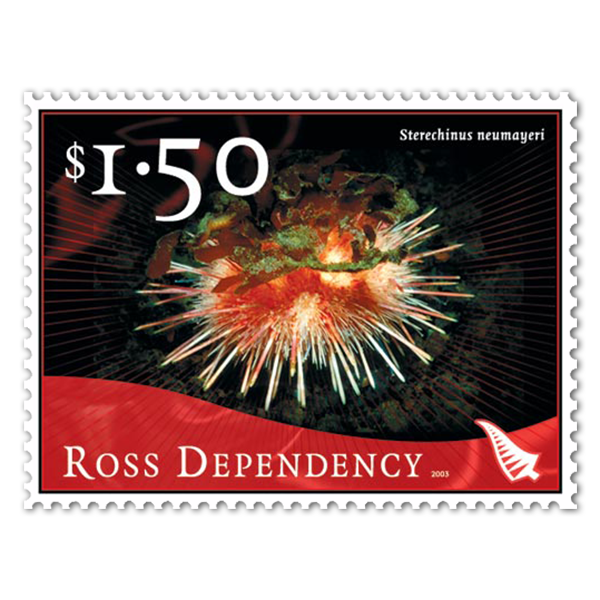 |
Single Stamp |
Single $1.50 'Sea Urchin (Sterechinus neumayeri)' gummed stamp. With its spiky exterior, the Antarctic sea urchin makes a spectacular sight on Antarctica's ocean floor, cruising along using its spines and sucker-tipped tube feet. Those pointed spines also play a role in the sea urchin's personal defence system, for it uses them to attach camouflage (bits of shell and debris) to itself - and escape the clutches of its predators. |
$1.50 |
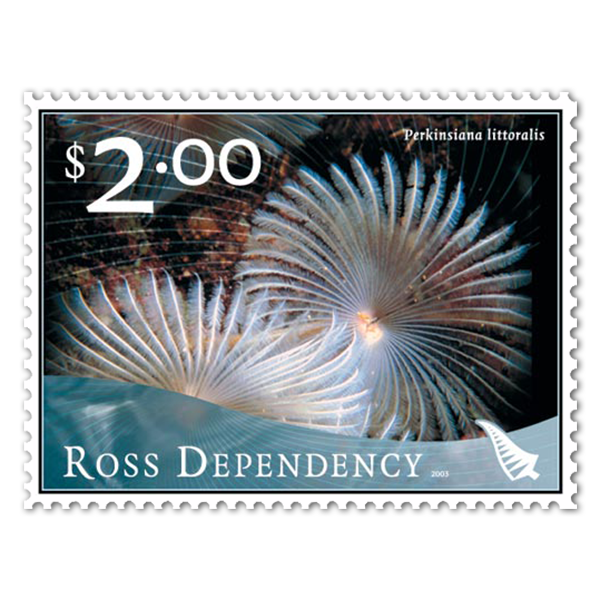 |
Single Stamp |
Single $2.00 'Fan Worm (Perkinsiana littoralis)' gummed stamp. Sometimes called the 'featherduster worm', this gorgeous creature grows up to 20 centimetres long and can be found at depths of up to 800 metres. The spectacular tentacular crown is a food-gathering net for the worm's suspension feeding habit - the outspread feathery radioles carry small food particles down to its central mouth. |
$2.00 |
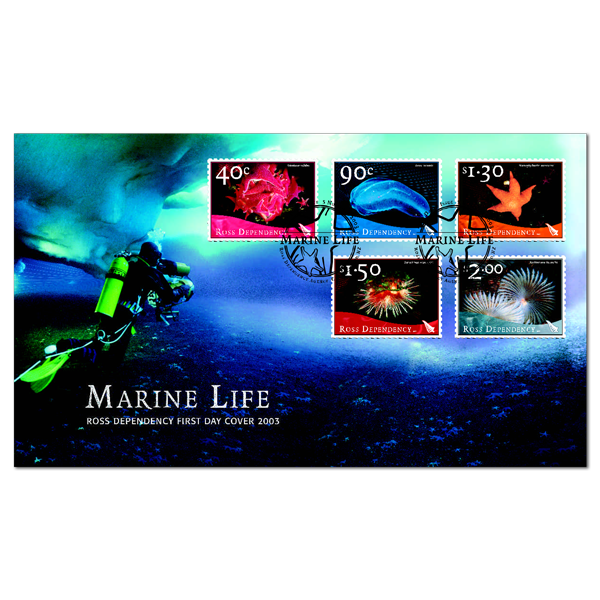 |
First Day Cover | First day cover with five gummed stamps affixed. Cancelled on the first day of issue. | $6.60 |
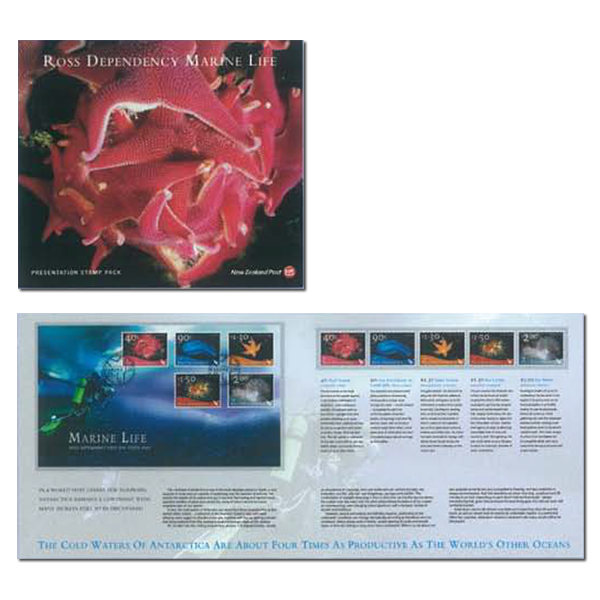 |
Presentation Pack | Presentation pack containing a selection of stamp products from the issue and further information on the theme of the stamps. | $16.95 |
Technical information
| Date of issue: | 1 October 2003 |
|---|---|
| Number of stamps: | Five |
| Denominations and designs: | 40c Red Seastar (Odontaster validus), 90c Sea Gooseberry or Comb Jelly (Beroe cucumis), $1.30 Giant Seastar (Macroptychaster accrescens), $1.50 Sea Urchin (Sterechinus neumayeri), $2.00 Fan Worm (Perkinsiana littoralis) |
| Stamps and first day cover designed by: | Chrome Toaster, Wellington |
| Number of colours: | Four process colours |
| Stamp size and format: | 30mm x 40mm (horizontal) |
| Printer and process: | Cartor Security Printing, France by offset lithography |
| Paper type: | 103gsm red phosphor stamp paper |
| Perforation gauge: | 13 |
| Number of stamps per sheet: | 50 |
| Special blocks: | Plate/imprint blocks could be obtained by purchasing at least six stamps from a sheet. Barcode, value and logo blocks could be obtained by purchasing at least two stamps from a sheet. Barcode blocks were available in A and B format. |
| Period of sale: | These stamps remained on sale until 4 November 2004. |

